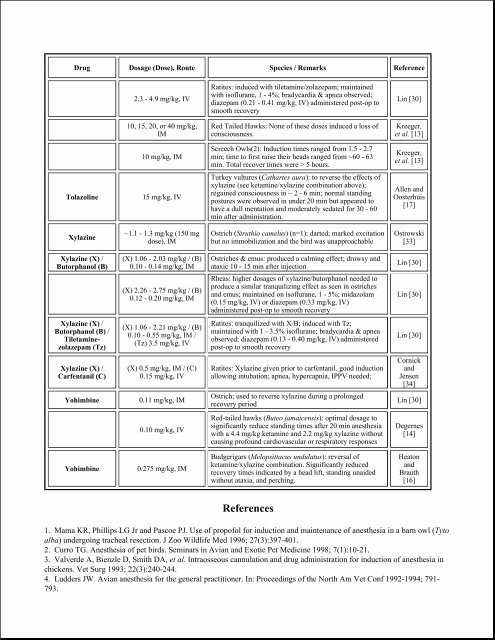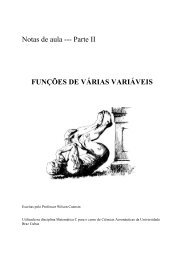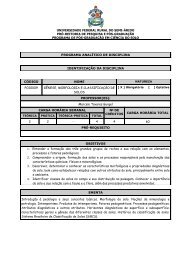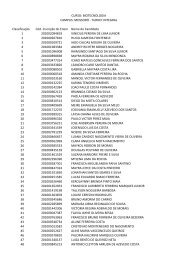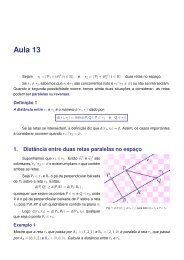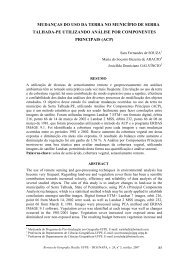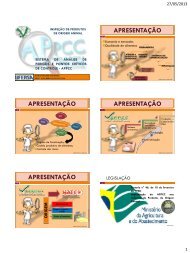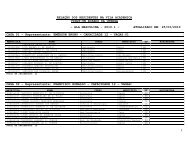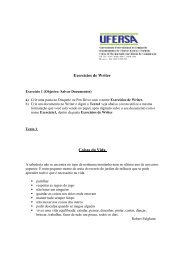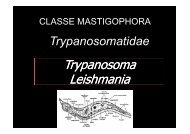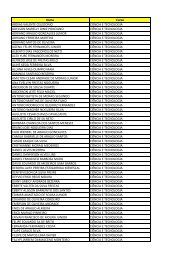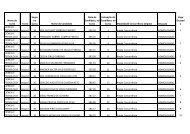Injectable Anesthesia and Analgesia of Birds by J. Paul ... - Ufersa
Injectable Anesthesia and Analgesia of Birds by J. Paul ... - Ufersa
Injectable Anesthesia and Analgesia of Birds by J. Paul ... - Ufersa
You also want an ePaper? Increase the reach of your titles
YUMPU automatically turns print PDFs into web optimized ePapers that Google loves.
Drug Dosage (Dose), Route Species / Remarks Reference<br />
2.3 - 4.9 mg/kg, IV<br />
Ratites: induced with tiletamine/zolazepam; maintained<br />
with is<strong>of</strong>lurane, 1 - 4%; bradycardia & apnea observed;<br />
diazepam (0.21 - 0.41 mg/kg, IV) administered post-op to<br />
smooth recovery<br />
Lin [30]<br />
10, 15, 20, or 40 mg/kg,<br />
IM<br />
Red Tailed Hawks: None <strong>of</strong> these doses induced a loss <strong>of</strong><br />
consciousness.<br />
Kreeger,<br />
et al. [13]<br />
10 mg/kg, IM<br />
Screech Owls(2): Induction times ranged from 1.5 - 2.7<br />
min; time to first raise their heads ranged from ~60 - 63<br />
min. Total recover times were > 5 hours.<br />
Kreeger,<br />
et al. [13]<br />
Tolazoline<br />
15 mg/kg, IV<br />
Turkey vultures (Cathartes aura): to reverse the effects <strong>of</strong><br />
xylazine (see ketamine/xylazine combination above);<br />
regained consciousness in ~ 2 - 6 min; normal st<strong>and</strong>ing<br />
postures were observed in under 20 min but appeared to<br />
have a dull mentation <strong>and</strong> moderately sedated for 30 - 60<br />
min after administration.<br />
Allen <strong>and</strong><br />
Oosterhuis<br />
[17]<br />
Xylazine<br />
~1.1 - 1.3 mg/kg (150 mg<br />
dose), IM<br />
Ostrich (Struthio camelus) (n=1): darted; marked excitation<br />
but no immobilization <strong>and</strong> the bird was unapproachable<br />
Ostrowski<br />
[33]<br />
Xylazine (X) /<br />
Butorphanol (B)<br />
(X) 1.06 - 2.03 mg/kg / (B)<br />
0.10 - 0.14 mg/kg, IM<br />
Ostriches & emus: produced a calming effect; drowsy <strong>and</strong><br />
ataxic 10 - 15 min after injection<br />
Rheas: higher dosages <strong>of</strong> xylazine/butorphanol needed to<br />
produce a similar tranquilizing effect as seen in ostriches<br />
<strong>and</strong> emus; maintained on is<strong>of</strong>lurane, 1 - 5%; midazolam<br />
(0.15 mg/kg, IV) or diazepam (0.33 mg/kg, IV)<br />
administered post-op to smooth recovery<br />
Lin [30]<br />
(X) 2.26 - 2.75 mg/kg / (B)<br />
0.12 - 0.20 mg/kg, IM<br />
Lin [30]<br />
Xylazine (X) /<br />
Butorphanol (B) /<br />
Tiletaminezolazepam<br />
(Tz)<br />
(X) 1.06 - 2.21 mg/kg / (B)<br />
0.10 - 0.55 mg/kg, IM /<br />
(Tz) 3.5 mg/kg, IV<br />
Ratites: tranquilized with X/B; induced with Tz;<br />
maintained with 1 - 3.5% is<strong>of</strong>lurane; bradycardia & apnea<br />
observed; diazepam (0.13 - 0.40 mg/kg, IV) administered<br />
post-op to smooth recovery<br />
Lin [30]<br />
Xylazine (X) /<br />
Carfentanil (C)<br />
(X) 0.5 mg/kg, IM / (C)<br />
0.15 mg/kg, IV<br />
Ratites: Xylazine given prior to carfentanil. good induction<br />
allowing intubation; apnea, hypercapnia, IPPV needed;<br />
Cornick<br />
<strong>and</strong><br />
Jensen<br />
[34]<br />
Yohimbine<br />
0.11 mg/kg, IM<br />
Ostrich; used to reverse xylazine during a prolonged<br />
recovery period<br />
Lin [30]<br />
0.10 mg/kg, IV<br />
Red-tailed hawks (Buteo jamaicensis): optimal dosage to<br />
significantly reduce st<strong>and</strong>ing times after 20 min anesthesia<br />
with a 4.4 mg/kg ketamine <strong>and</strong> 2.2 mg/kg xylazine without<br />
causing pr<strong>of</strong>ound cardiovascular or respiratory responses<br />
Degernes<br />
[14]<br />
Yohimbine<br />
0.275 mg/kg, IM<br />
Budgerigars (Melopsittacus undulatus): reversal <strong>of</strong><br />
ketamine/xylazine combination. Significantly reduced<br />
recovery times indicated <strong>by</strong> a head lift, st<strong>and</strong>ing unaided<br />
without ataxia, <strong>and</strong> perching.<br />
Heaton<br />
<strong>and</strong><br />
Brauth<br />
[16]<br />
References<br />
1. Mama KR, Phillips LG Jr <strong>and</strong> Pascoe PJ. Use <strong>of</strong> prop<strong>of</strong>ol for induction <strong>and</strong> maintenance <strong>of</strong> anesthesia in a barn owl (Tyto<br />
alba) undergoing tracheal resection. J Zoo Wildlife Med 1996; 27(3):397-401.<br />
2. Curro TG. <strong>Anesthesia</strong> <strong>of</strong> pet birds. Seminars in Avian <strong>and</strong> Exotic Pet Medicine 1998; 7(1):10-21.<br />
3. Valverde A, Bienzle D, Smith DA, et al. Intraosseous cannulation <strong>and</strong> drug administration for induction <strong>of</strong> anesthesia in<br />
chickens. Vet Surg 1993; 22(3):240-244.<br />
4. Ludders JW. Avian anesthesia for the general practitioner. In: Proceedings <strong>of</strong> the North Am Vet Conf 1992-1994; 791-<br />
793.


